Ultrasonic Thickness Gauging Services. NABL Accredited Lab.
NDT Level II Certified Technicians. In-house ASNT Level III Ultrasonic Experts.
Ultrasonic Thickness Testing for Corrosion. Chimneys, Pipelines, Tanks, Boiler Parts.
Ultrasonic Thickness Test Services in Bangalore. Corrosion mapping of pipelines, chimneys, boiler tubes. NABL accredited Lab. Onsite Inspection.
Ultrasonic Thickness Gauging Services in Bangalore
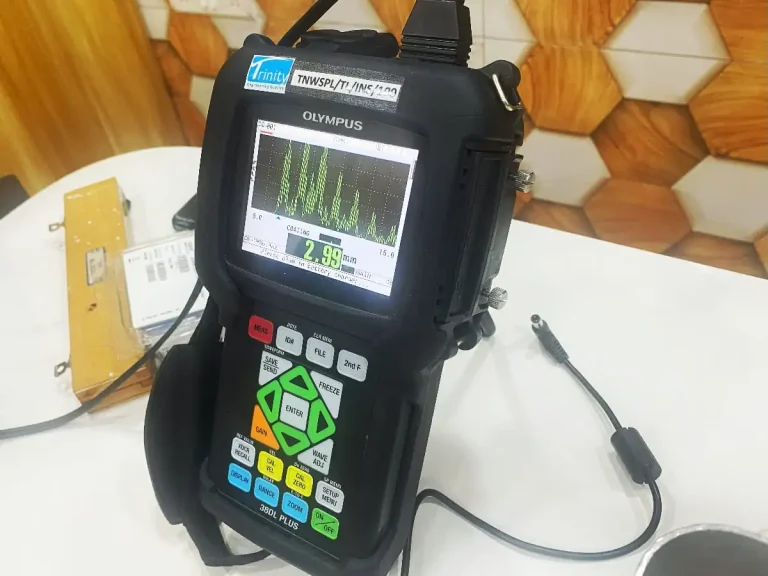
Ultrasonic thickness gauging services provider in Bangalore. Measuring wall thickness of chimneys, boiler pipes, other parts for corrosion. Reduction of wall thickness beyond critical level leads to leakages, failure of structures. Digital wall thickness testing using ultrasonic principle is an effective detection method. ‘Trinity NDT’ provides, onsite pipe wall thickness testing. Specialized machines for corrosion mapping of oil, gas pipe lines in India. Services range from simple tests to detailed analysis for C-scan corrosion mapping.
Ultrasonic Gauges for wall thickness on painted, coated objects available. Services covered under NABL accreditation as per ISO17025 on NDT. ASNT/ISO9712 certified Level I, II technician perform inspections. Experienced technicians for onsite inspection. High altitude structures, chimneys, pipe lines. Special probes for thickness gauging of boiler tubes, welds, parts at elevated temperature. Lab for testing on metals, non-metals such as plastics, composites, glass and ceramics at Bangalore.
Onsite, in-lab facility for Ultrasonic thickness gauging. Accuracy of up to 0.001mm. Olympus, USA make equipment, probes. Serving 1500+ clients in India since 2001. In-house ASNT Level III in UT at Bangalore for evaluation of results. Accessible for customers onsite inspections of fixed installations in Hosur, Mysore. Approved from GAIL India, HAL, BEL, Siemens, GE and others.
Experience our award winning Ultrasonic thickness testing services today. Just a phone call/WhatsApp call to connect with us.
Chimney Wall Thickness Testing Services for Corrosion
Power, process plant Chimneys expel exhaust gases, smoke. Height of above 100meters above the ground. Causing wall thinning as smoke passes. Salts in the air, fumes leads to oxide formation on inside wall. Over a period of time oxide layer increases. Gradually wall thickness reduces to a critical level. If unable notice during in-services inspection, causes collapses whole or part of structure. As they bear massive self load, wind, drafts, structure shall withstand adverse conditions.
Preventive maintenance schedules demand wall thickness testing. Use Ultrasonic thickness gauging at planned intervals. Corrosion mapping of Chimneys helps to asses residual life of structure. Suitable measures to prevent failure, extends life. Continuous monitoring of wall thickness helps in identifying potential areas of corrosion, pipe thinning. We mark specific areas for pre-cleaning before performing the inspection. Suitable scaffolding to be arranged by client to access critical areas.
Modern equipment accuracy can go up to 0.001mm or even better. Depends on factors,
- surface condition,
- calibration procedure,
- temperature of component and
- type of couplant
Though ‘resonance technique’ can give wall thickness, ‘pulse echo’ Ultrasonic thickness gauges deliver better results. Operates from 500 KHz to 100MHz range.
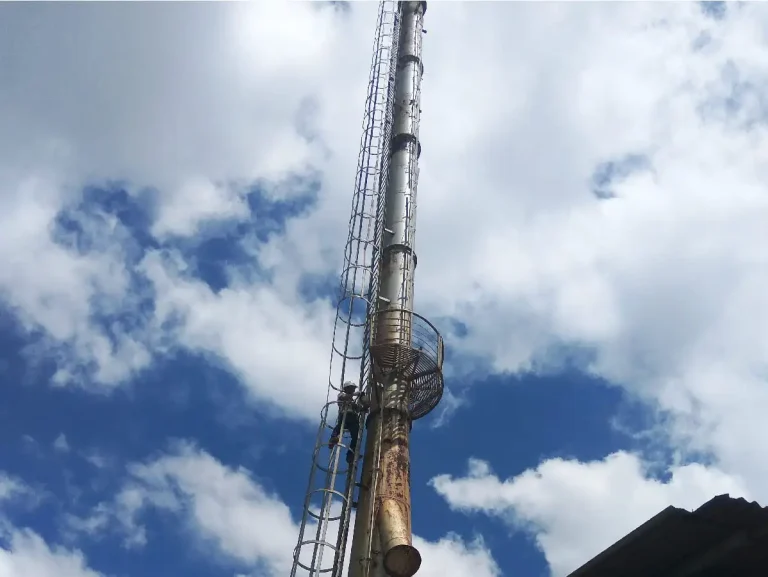
Wall thinning - Boiler Tubes, Pressure Vessel Inspection
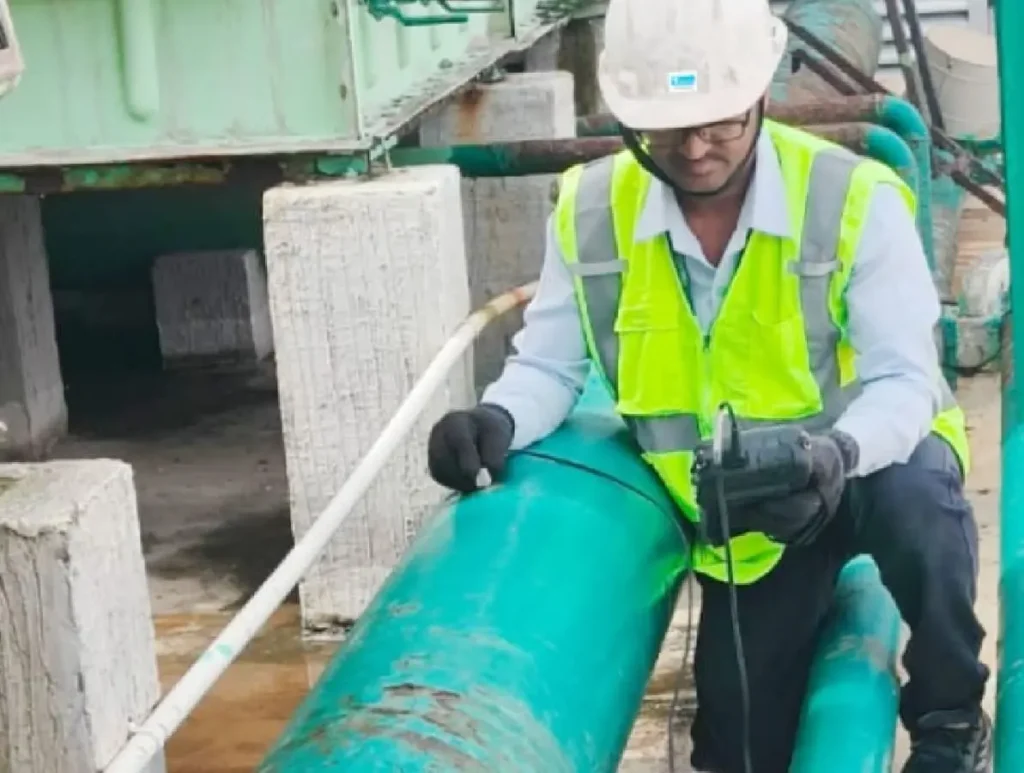
During manufacturing, Boiler pipes, tubes needs to be bent for a specific radius. While bending, the outer wall expands, whereas, inner wall compresses. Earlier, to finally produce 100 Nos of tubes, needs to make 101 Nos. Extra one tube randomly selected to be cut at bent portion. To check wall thickness using vernier or micrometer. Of course it is a destructive means of testing. High risk involved in choosing sample as it may not truly resemble defective tube.
With the invention of Ultrasonic thickness gauging – UTG, now possible to measure wall thickness. Not only eliminates risk in sample selection, this helps to test every boiler tube.
Boiler tubes exposed to hot gases, moisture borne air leading to loss of wall thickness. High economic losses to the organizations that do not do planned maintenance inspections. Managements have become smarter. Introduced Ultrasonic thickness gauging for routine inspection. Power plants, refineries, steel plants and other process companies use in-service wall thickness to asses condition. Our expert NDT Level II technicians calibrate UTG equipment onsite, measure, record results.
Equipment, Accessories at Trinity NDT Labs
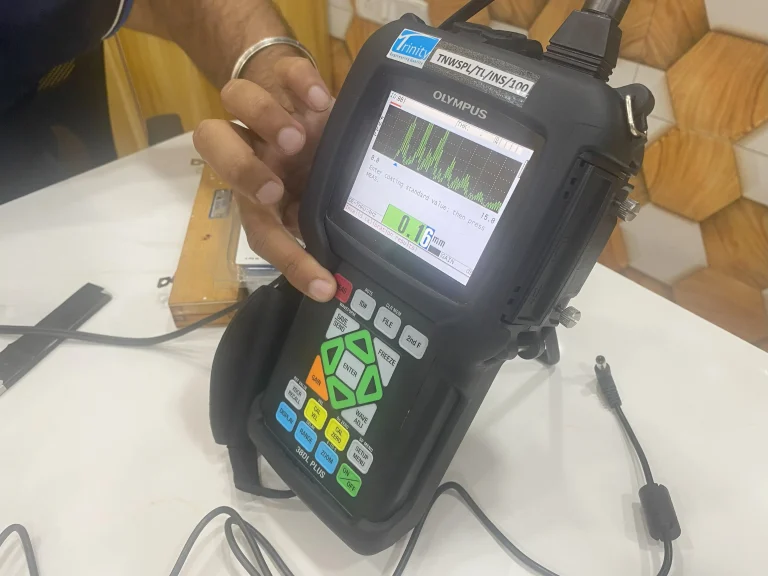
Our Ultrasonic testing lab is fully equipped to serve customers in around Bangalore. Team to provide onsite inspections in Hosur, Mysore regions. Basic machines to advance digital thickness measuring machines. Simple wall thickness of castings, pipes, tubes and tanks. Critical oil, gas pipe line corrosion, we are experts in delivering services in India.
Olympus Make – Model 39DL Plus equipment. Ready to take challenges of demanding industries, including in-service, manufacturing, and energy production, aerospace. Through coat thickness measuring capability. Probes for general applications. High temperature probes for elevated hot surface thickness testing.
Calibration, Reference Standards for UTG
To ensure precise measurements, equipment need calibration. One or more reference blocks with known velocities needed to perform. Block thicknesses accurately measured, ideally falling within the range to be measured. We aim for ’round number’ thickness values rather than using miscellaneous odd values. A reference block with a thickness near the maximum of the desired range and one at minimum thickness can enhance measurement accuracy.
As a minimum, two reference standards required. One 50 – 90% of the nominal thickness to be measured. Other 110 – 150% of the nominal thickness.Standard needs to measurement mechanically or optically. NDT procedures state that the maximum tolerance for these measurements shall be one-half the tolerance permitted. Test part needs to be tested within a tolerance of +0.254mm. The thickness of the reference standards tolerance allowed +0.127mm.
If the part measurement tolerance is not specified in the NDT procedure, the reference standards should be measured within +0.127mm or one-half the instrument tolerance, whichever is greater. A test part can be used as reference standard if it meets the surface finish requirements. Two or more ares on the test part can be measured mechanically or optically.
International Standards
Below are the international standards we follow for Ultrasonic thickness gauging services:
ASTM E797 – Standard Practice for Measuring Thickness by Manual Ultrasonic Pulse-Echo Contact Method.
ISO 16809:2017 – Nondestructive testing Ultrasonic Thickness Measurement.
Personnel Qualification, Certification on UTG Level I, II
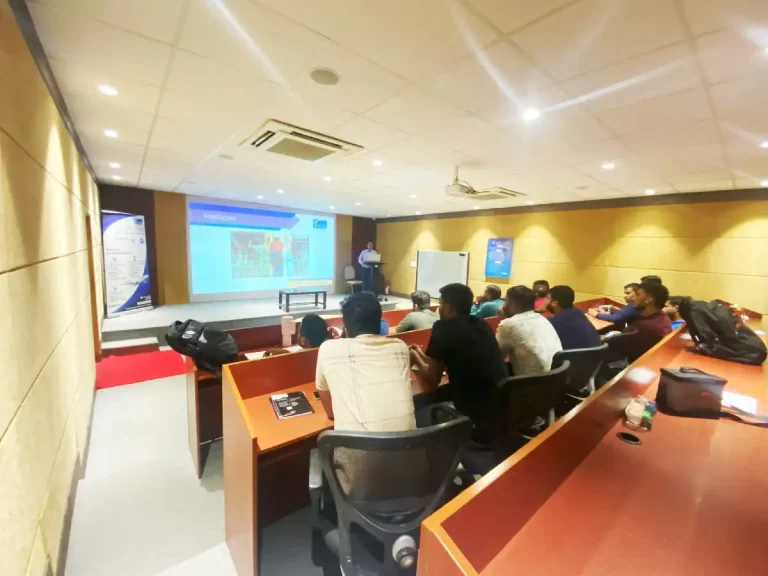
Personnel conducting Ultrasonic thickness test shall possess qualifications aligned with nationally or internationally recognized standards.
Our technicians are qualified, certified. As per written practice approved by ASNT Level III as per ANSI/ASNT CP-189, SNT-TC-1A. ‘Trinity Institute of NDT Technology‘ offers limited certification on Ultrasonic Thickness Gauging Level II for technicians.
Contact us for more information about qualification, certification courses on NDT, welding inspection.Materials for Ultrasonic thickness testing, Applications
Majority of engineering materials can be tested using ultrasonic thickness gauging (UTG). Metals, plastics, glass, ceramics, epoxies and composites.
Number of other applications include:
-Verifying component thickness when access to the other side is impossible
-Inspecting material loss due to wear or corrosion
-Testing material thickness with an accuracy of +0.001mm
To summarise, any material that passes ultrasonic waves can be effectively tested using digital thickness gauging machines.
Check our NDT, Welding Services
- NABL accredited NDT testing service
- Radiography x-ray testing
- Eddy Current testing
- Ultrasonic Testing UT Service
- Magnetic particle inspection
- Demagnetization service
- Dye penetrant Testing
- Visual Welding Inspection
- ASNT, NAS410 Level III consulting
- Welder Qualification certification
- Certification courses on NDT and Welding
- Aerospace NDT Services
- NADCAP accredited Aerospace Labs

